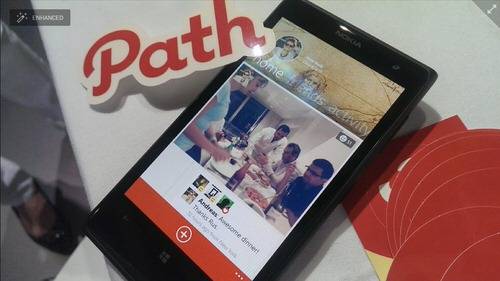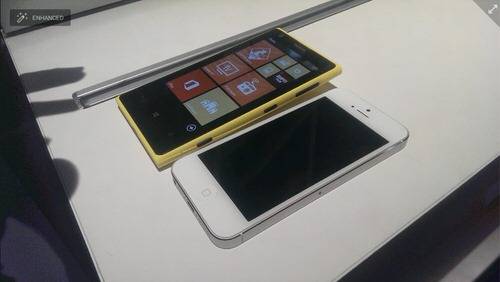
When Nokia unveiled its brand new hero device yesterday, it was very easy to look at the Lumia 1020 as kind of a freak joke of a smartphone. Sporting a 41-megapixel camera that gives the device a significant bump on the back, the Lumia 1020 is hardly being presented as a smartphone at all, but really a camera that can use apps and make phone calls.
To let the insane camera (which is as good, or better, than advertised) and the pricey $299 price tag (on a two-year contract with AT&T) deter you from what Nokia is doing would be a mistake. The Lumia 1020 is no gimmick smartphone being presented as a hero device. Nokia may be doing what many thought would be impossible.
It is starting to make the Windows Phone platform look cool.
How is Nokia doing this? By breaking away from the Microsoft-centric development of Windows Phone and creating new, creative ways for developers to take advantage of Nokia features. Features such as Nokia’s HERE maps program and the new Imaging SDK (software developer kit) give developers real incentive to build for the Lumia line while making Microsoft and Windows Phone tangential to the conversation.
Nokia Understands Its Onus To Improve Windows Phone

During the unveiling of the Lumia 1020 on stage in New York City yesterday, Nokia CEO Stephen Elop opened the floor for a brief question-and-answer session. The first few questions asked to clarify features for the device and its sales strategy. Then, Forbes reporter Joan Lappin dropped a bomb on Elop, calling its exclusive carrier partner in the United States—AT&T—dreadful and prompting Elop to take a broader look on the smartphone ecosystem rather than just focus on the question of AT&T at hand.
Elop’s comments to Lappin are enlightening in that Nokia’s CEO shows a grudging understanding of the dynamics of the smartphone industry and the dominance of Apple and Samsung. He doesn’t throw AT&T under the bus, but rather says that it is entirely Nokia’s responsibility to make Windows Phone an attractive option.
“We made the bold decision to not just try and create another set of phones with a common operating system that so many others have pursued. We said, we are going to create the third ecosystem. And with that decision came tremendous responsibility to actually help–whether it is a retail sales associate, an operating partner, consumers, the press, everyone—to understand what that third alternative stands for,” Elop said. “And we stand by that decision because … That whole dynamic has changed. And yet our growth, our growth and market share, that is what we are building on day by day is coming because we made that whole choice.”
The Nokia Image SDK: Creating A Library For Lumia Apps

So, the Lumia 1020 has an impressive camera. Great. Other smartphones have pretty good cameras too. Lost amidst the hubbub about a smartphone with a 41-megapixel camera was the Nokia Imaging SDK, a tool for developers to create interesting features, filters and functions for the camera in their apps. The first apps to use the SDK are Hippstamatic Oggl PRO, Vine, Path and Flipboard.
For developers, the Imaging SDK presents several functions to integrate into Windows Phone 8 apps:
- 50 filters, effects, enhancements: Auto-frame, advanced hue and saturation and the ability to create unique effects by chaining together several features from the SDK.
- Photo editor: Crop, rotate, resize and so forth to add a picture editor to any app on Windows Phone 8.
- Partial JPEG decoding: The ability to access image data without decoding the entire image for faster previews and functionality.
- Application Programming Interface: The Imaging SDK brings the “WinPRT” library for images. Can be managed in native codes (C#, VB and native C++).
Mobile social network Path is taking advantage of the SDK by adding the ability to add filters to photos and edit within the app. Path thinks that photos are one of its most important features and the ability to take advantage of the camera on the Lumia 1020 was an enticing feature.
Microsoft is well known to outright pay developers to build apps for its platforms. Path representatives (citing a strict non-disclosure agreement) would not comment on if Microsoft and/or Nokia paid Path to develop that app, calling it a “mutual effort” with Path developing its new Windows Phone app for the Lumia 1020 in-house with assistance from both Nokia and Microsoft.

However Microsoft and Nokia enticed the likes of Path and Flipboard to build for Windows Phone 8 is not important. What is important is that Nokia has created tools and a platform for developers to build great functionality for a Nokia device, something that it had not specifically done in its Windows Phone partnership with Microsoft before. Sure, Nokia has put its location and maps and a couple other functions into its Windows Phones before, but it had never really built a platform for developers to really build for the Lumia line.
The Imaging SDK shows that Nokia is serious about taking its own future into its hands to improve both Windows Phone and Nokia-specific devices.

Challenges Still Await
Smartphone pundits have come out of the woodwork to criticize Nokia’s distribution decision for the Lumia 1020. Likely emboldened by Lappin’s on-stage grilling of Elop, mobile analysts have basically called the decision to sell the Lumia 1020 exclusively on AT&T for $299 baffling. We have seen time and again that partner exclusivity has presented problems for smartphone manufacturers. HTC was hit hard last year by partnering with AT&T for its One X flagship and later the Verizon Droid DNA. The Lumia 900 and 920 on AT&T have not fared particularly well in the U.S. either.
Part of Nokia’s challenge has been distribution, marketing and deployment of its flagship Lumia smartphones. The other part of the challenge is that consumers either do not understand or just do not like Microsoft’s Windows Phone. Or maybe there are not enough apps in the Windows Phone Marketplace. Or, or, or … we could pick any number of reasons from a hat as to why Windows Phone has not done appreciably well on the market after several years of trying.
Like it or not, Nokia is going to be locked into Windows Phone until the company succeeds or dies a gruesome death. And as the Lumia 1020 shows, Nokia is not going down without a fight.

















